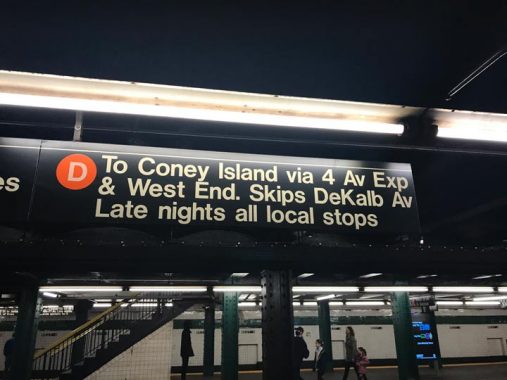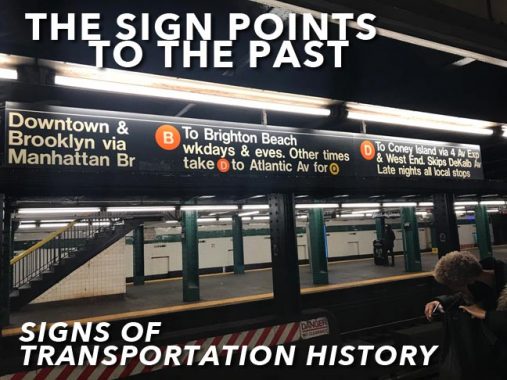
*I’m doing something a bit different this Sunday; instead of the usual longform page, I’m doing a shorter page because I was just hired part time at Marquis Who’s Who in America, and have to look at paperwork and sample writing before starting on Monday.
I was waiting for a train to Coney Island on a recent Saturday on the West 4th Street platform. Two of the available subways here go straight to Coney Island, the D and the F (during the week, B trains get as far as Brighton Beach) and the F was not running to Coney this weekend, so the D it was. I hadn’t taken the D to Coney in quite awhile; of late, to get there I’d been using the N and Q trains, which run up Broadway, while the D and F use 6th Avenue.
I noticed something about the signs. I have been a fan of the iconography of subway signs as well as street signs, they’re the “uniforms” for inanimate objects that the Metropolitan Transit Authority and NYC Department of Transportation wear. The MTA’s style, white Helvetica lettering on black signs, began with Massimo Vignelli and Bob Noorda’s Unimark, which, true to its name, “unified” subway signage under one marking system. The Unimark system has evolved over time, but is basically the same system instituted in 1968.

These signs still refer to the D as the “West End” and the F as the “Culver.” Now, these are designations for trains running in southern Brooklyn that have their own names, with the Sea Beach (N) and Brighton (B, Q) joining the party. Frankly, I can’t imagine any subway rider younger than 50, other than railbuffs, who uses these names other than the letters. Does anyone still say, “I’m getting the West End to Coney Island” instead of “I’m taking the D to Coney Island”?
Even more amazingly, these names originated in the 1880s, when steam railroads plied the routes that the current trains, on tracks now electrified with third rails and mounted on elevated structures and embankments.
The West End
in 1863, a steam railroad built by Charles Godfrey Gunther, a former NYC mayor, was built from the entrance to Green-Wood Cemetery to Bath Beach. The line necessitated a transfer at 36th Street (just as today’s subways do from the D to the N and R) because steam railroads were forbidden in Brooklyn in that era. A horsecar line completed the run from 5th and 36th to 5th and 25th. The steam line was completed out to Coney Island in 1864, where it met the West End Hotel. After an 1885 reorganization the line became the Brooklyn, Bath and West End Railroad, was electrified by overhead catenary wire in 1893, was acquired by Brooklyn Rapid Transit in 1898, and finally, was replaced by the West End Elevated in November 1916. Unfortunately, Gunther’s name never attached itself to subsequent iterations of his railroad the way Andrew Culver’s did to what is now the F train in Brooklyn.
Charles Gunther’s Railroad [thirdrail.net ]
New Utrecht Avenue, Naked [FNY]
The Sea Beach
The New York and Sea Beach Railroad ran from a ferry landing in Bay Ridge to the Sea Beach Palace Hotel in Coney Island beginning in 1876, the country’s centennial. At first, it was a steam railroad running through open country, through an occasional small settlement or town. Brooklyn became slowly urbanified in the late 19th Century and a street grid appeared, with the railroad then running in a right of way between 63rd and 64th Streets as far as 21st Avenue, when it turned south and ran between West 7th and 8th Streets. In 1915, the route was electrified and placed in an open cut; since the 1960s, it’s been the N train, but it’s never lost its former “Sea Beach” designation.
The Brighton Line
In 1877, the Brooklyn, Flatbush and Coney Island Railway was incorporated, opening the next year in 1878. It originally ran from the Prospect Park entrance at Flatbush and Ocean Avenues south to the Brighton Beach Hotel, built near the water’s edge.
After 1882, when the Long Island Rail Road took over a BF&CI competitor, the New York and Manhattan Beach Railroad, it found itself competing with itself for suburban railroad customers. The NY&MB had been created by LIRR chief Austin Corbin before that railroading giant assumed control of the LIRR, and accordingly, the LIRR evicted the BF&CI from its trackage at the end of 1883 after just six years in service. BF&CI service was truncated to the Bedford Terminal at Frankin and Atlantic Avenues, where there was a turntable for turning the steam engines.
No longer having a desirable northern terminal, the BF&CI was forced into bankruptcy and was reorganized in 1887 as the Brooklyn and Brighton Beach Railroad. The next year the Brighton Beach Hotel was moved inland–by railroad–to keep it from slipping into the sea. In 1896, the problem of what to do with the northern end of the line was solved when a ramp was built to connect new Kings County Elevated that ran along Fulton Street to the Brooklyn & Brighton Beach from a junction at Franklin and Fulton, bridging Atlantic Avenue and connecting to the Brighton several blocks south of that point.
Over time, the steam railroad was both electrified and truncated, becoming today’s Brighton Line (B,Q) running to Coney Island and the portion from Prospect Park to the Fulton El is still run as a two-car shuttle. Over the decades the MTA neglected the shuttle until it became dangerously decrepit, but it was virtually rebuilt at the end of the 1990s. Today it transfers to the local Franklin Avenue stop on the C train under Fulton Street.
Transit buffs recall the Culver Shuttle, which ran between 1954 and 1975 and was itself a remnant of the old Culver Line, which was preceded by a steam railroad line, the Prospect Park and Coney Island, which beginning in 1875 ran between 9th Avenue and 20th Street to the present Shell Road and Avenue X.
The line was built by railroad entrepreneur Andrew N. Culver, an early player in railroad development in southern Brooklyn, and he also branched into hotel development. Culver, with the aid of enterpreneur Thomas Cable, built Culver Plaza North at today’s Surf Avenue and West 5th Street, to house and cater to wealthy seaside visitors.
Cable’s Hotel opened for business well before the railroad did. Only men were permitted to stay at the hotel, but women and children were welcome to dine in its restaurant. Cable seemed to have in mind an English style gentlemen’s club, in which they could drink their whiskies and soda, smoke their cigars, read their newspapers, and discuss business, politics, sports, and show girls. Cable was also said to have had the best wine cellar in Coney Island. [Heart of Coney Island]
Years after the seaside hotels of Coney have been razed; decades after the Culver steam railroad stopped running and was replaced by an elevated train — Andrew Culver is still remembered on station signage, as well as route markings on the R-46 trains that ply the F train.
Thus, when you look at a modern subway sign in any given station, you may be looking at nomenclature that stretches back nearly 150 years.
For the complete story of southern Brooklyn’s railroads, see Brian Cudahy’s How We Got to Coney Island.
Check out the ForgottenBook, take a look at the gift shop, and as always, “comment…as you see fit.” I earn a small payment when you click on any ad on the site.
4/11/21
